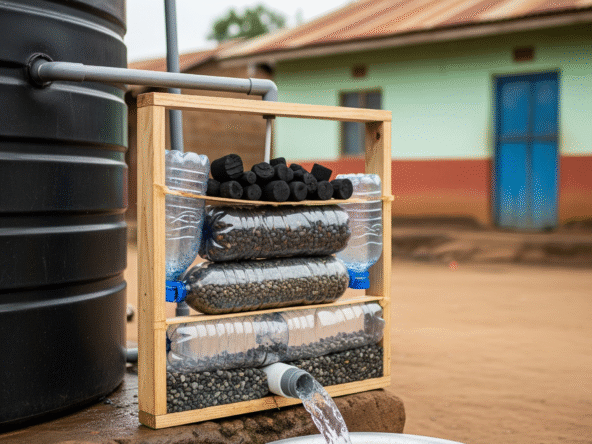In a country where water scarcity and unpredictable supply are increasingly common, having the right water tank isn’t just convenient it’s essential. Whether you’re building a rural homestead, managing a rental unit, or running a small farm, selecting the right tank size ensures that your water storage system matches your daily usage, seasonality, and budget.
In this guide, we explore the most common water tank sizes in Kenya, from 500 litres to over 10,000 litres. We’ll also look at practical use cases, price estimates, and installation tips to help you make the best choice for your home or plot.
Understanding Your Daily Water Needs
The first step in choosing the right tank size is knowing how much water you actually use. Here’s a quick estimate based on household and farm types:
- A small home with one or two occupants may consume 200 to 400 litres per day.
- A medium-sized household of four to six people might use 600 to 1,000 litres daily.
- A rental block with about four units could need 2,500 to 3,500 litres daily.
- Small farms vary widely but can consume anywhere from 2,000 to 10,000 litres per day depending on crop and livestock demands.
If your household uses 1,000 litres daily, a 5,000 litre water tank will give you a solid five-day buffer, especially useful during rationing or dry spells. For more insights on tank brands and quality options, check out Top Water Tank Brands in Kenya.
Most Common Water Tank Sizes and Their Best Uses
Here’s how different tank sizes match various needs:
- 500 Litre Tank – Perfect for short-term storage, cooking, or cleaning water. Great for site works or temporary setups.
- 1000 Litre Tank – Ideal for small households or gardens.
- 2000 Litre Tank – Works well for medium homes or as a backup tank for borehole systems.
- 3000 Litre Tank – A solid choice for rental compounds or small-scale livestock watering.
- 5000 Litre Tank – One of the most balanced sizes for large households, small estates, or commercial water usage.
- 10,000 Litre Tank – Best for farms, borehole storage, estates, or linking into a rainwater harvesting system.
If you’re looking to improve compound productivity, pairing your tank with backyard eco-practices—like composting—makes sense. Read How to Integrate Composting into Backyard Gardens for ideas.
Underground vs. Above-Ground Water Tank Installations
Space and layout often dictate where your tank goes. If your plot is small or paved, an underground tank can free up space while storing a significant volume of water. Most underground tanks start at around 3,000L but can go up to 20,000L+ depending on design.
Above-ground plastic (poly) tanks remain the most popular choice in Kenya for their affordability and ease of maintenance. Sizes like 1,000L, 3,000L, or 5,000L offer enough flexibility for most homes and can be upgraded easily.
If you’re paving your compound, consider reading Compound Paving Alternatives in Kenya to learn how your tank system can integrate with outdoor landscaping.
How Much Do Water Tanks Cost in Kenya?
Tank prices vary depending on the material, brand, and region. Here’s a general guide:
| Size | Price Range (KES) |
|---|---|
| 500 Litre | KSh 4,000 – 6,500 |
| 1000 Litre | KSh 8,000 – 12,000 |
| 2000 Litre | KSh 13,000 – 18,000 |
| 5000 Litre | KSh 23,000 – 35,000 |
| 10,000 Litre | KSh 55,000 – 90,000 |
For permanent setups, many users are opting for concrete water tanks, steel tanks, or even IBC tanks, depending on their durability and volume needs. All options come with pros and cons regarding cost, lifespan, and maintenance.
Boosting Your Water System: Add-Ons That Matter
A tank isn’t just a standalone item—it’s part of a system. To make the most of your storage setup, consider these additions:
- Rain gutters and mesh filters to collect clean rooftop water. See Rainwater Harvesting in Kenya for full setup guidance.
- A metal tank stand or elevated concrete slab to allow gravity-fed water flow.
- Water pressure pumps to increase flow to taps and showers.
- A properly sized soak pit to handle overflow during heavy rains. Learn how to design one via Soak Pit Design for Residential Plots.
Together, these elements ensure consistent, safe water supply for both domestic and agricultural use.
Choosing the right water tank size comes down to a combination of daily usage needs, budget, and available space. For most homes in Kenya, a 2,000L to 5,000L tank offers the best mix of affordability and functionality. If you’re managing a farm, estate, or multiple rental units, consider scaling up or linking tanks to meet higher demand.
Also remember that water storage should align with your entire compound layout think about where overflow goes, how your paving affects runoff, and how your outdoor features like seating or gardens might benefit from having water nearby.
For more ideas on optimizing compound design, see:


